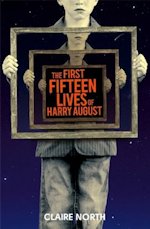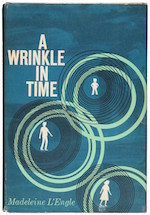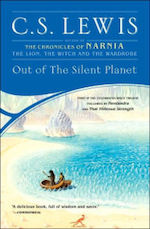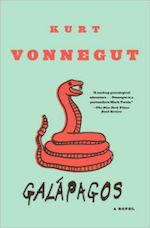Among the defining features of speculative fiction (in addition to awesomeness) is a departure from the world we recognize as our own—the “what if” that puts the speculation in speculative fiction. These departures can be small or large, plausible or outlandish—from extrapolations on things to come that feel logical, even inevitable, like the mission to Mars in Andy Weir’s The Martian, to pure flights of whimsy, as in Lewis Carrol’s Alice in Wonderland. Between the extremes of hard science and pure fantasy, there lies an infinite spectrum of never-was and yet-to-be, reinvented realities part fancy, part prophecy.
Below, I’ve collected a few that fall somewhere along the middle of that spectrum, stories with a cocktail of science fiction and fantasy.
The First Fifteen Lives of Harry August by Claire North
 As the title implies, this is a story of reincarnation—of sorts. Harry August is a “Kalachakra”, a person who lives his life in cycles, repeating the same life again and again (in Harry’s case, 1919 until the late twentieth or early twenty-first century, depending on how reckless he is with that particular body). His isn’t a unique condition, however: there are others like him, each living their own unique lifespans, traveling together—and remembering each other—from one replay of history to the next. Most get along well, forming communities within “linear” society that persist along an extra dimension of time, but others rock the boat of history using knowledge of their past lives. When two Kalachakra come into conflict—over matters of quantum physics, no less—the result is a kind of spy novel played out within and across fifteen different versions of the twentieth century.
As the title implies, this is a story of reincarnation—of sorts. Harry August is a “Kalachakra”, a person who lives his life in cycles, repeating the same life again and again (in Harry’s case, 1919 until the late twentieth or early twenty-first century, depending on how reckless he is with that particular body). His isn’t a unique condition, however: there are others like him, each living their own unique lifespans, traveling together—and remembering each other—from one replay of history to the next. Most get along well, forming communities within “linear” society that persist along an extra dimension of time, but others rock the boat of history using knowledge of their past lives. When two Kalachakra come into conflict—over matters of quantum physics, no less—the result is a kind of spy novel played out within and across fifteen different versions of the twentieth century.
A Wrinkle in Time by Madeleine L’Engle
 Published in 1963, A Wrinkle in Time is classic of young folks’ literature and a perennial hit on the ALA’s list of most challenged books (in itself a strong recommendation). It follows 13-year-old Meg Murray as she adventures across a series of far flung worlds by way of the titular wrinkle (a folding of space readers might recognize as a wormhole) in search of her missing father. Along the way, she encounters an idyllic planet of centaurish creatures, battles social conformity in a world ruled by a telepathic, disembodied brain, and faces down a creeping embodiment of evil. Not a bad way to start your teenage years!
Published in 1963, A Wrinkle in Time is classic of young folks’ literature and a perennial hit on the ALA’s list of most challenged books (in itself a strong recommendation). It follows 13-year-old Meg Murray as she adventures across a series of far flung worlds by way of the titular wrinkle (a folding of space readers might recognize as a wormhole) in search of her missing father. Along the way, she encounters an idyllic planet of centaurish creatures, battles social conformity in a world ruled by a telepathic, disembodied brain, and faces down a creeping embodiment of evil. Not a bad way to start your teenage years!
Out of the Silent Planet by C.S. Lewis
 Before The Chronicles of Narnia, Clive Staples Lewis (better known by the initials C.S.) published The Space Trilogy, an epic of supernatural and interplanetary proportions. The first of the trilogy’s novels, Out of the Silent Planet, follows Cambridge professor Elwin Ransom (a character supposedly based on Lewis’s friend and fellow name-initialer J.R.R. Tolkien) to the planet Mars, which he discovers to be not only full of life but ruled by angelic beings—a feature common to every planet in the solar system, it turns out, though Earth’s guardian (or Oyarsa) became corrupted and was imprisoned there. The text’s Christian allegory won’t come as any surprise to readers of Lewis’s other work, but remains subtle for the most part (the second novel in the series, Perelandra, is another matter) and, as with Narnia, the storytelling stands on its own.
Before The Chronicles of Narnia, Clive Staples Lewis (better known by the initials C.S.) published The Space Trilogy, an epic of supernatural and interplanetary proportions. The first of the trilogy’s novels, Out of the Silent Planet, follows Cambridge professor Elwin Ransom (a character supposedly based on Lewis’s friend and fellow name-initialer J.R.R. Tolkien) to the planet Mars, which he discovers to be not only full of life but ruled by angelic beings—a feature common to every planet in the solar system, it turns out, though Earth’s guardian (or Oyarsa) became corrupted and was imprisoned there. The text’s Christian allegory won’t come as any surprise to readers of Lewis’s other work, but remains subtle for the most part (the second novel in the series, Perelandra, is another matter) and, as with Narnia, the storytelling stands on its own.
Perdido Street Station by China Miéville
 China Miéville’s introduction to the fictional world of Bas-Lag features a setting so deeply and diversely drawn that it might arguably be called the novel’s main character. The city of New Crobuzon is a sprawling megalopolis teeming with the weird and fantastical, a place where magic and steampunk-like technology exist side-by-side with inter-dimensional alien minds and artificial intelligences. The plot takes on everything from art to government corruption to organized crime, a story as psychedelically panoramic as the city in which it takes place, a world that imagines all manner of weirdness and somehow finds a place for it all.
China Miéville’s introduction to the fictional world of Bas-Lag features a setting so deeply and diversely drawn that it might arguably be called the novel’s main character. The city of New Crobuzon is a sprawling megalopolis teeming with the weird and fantastical, a place where magic and steampunk-like technology exist side-by-side with inter-dimensional alien minds and artificial intelligences. The plot takes on everything from art to government corruption to organized crime, a story as psychedelically panoramic as the city in which it takes place, a world that imagines all manner of weirdness and somehow finds a place for it all.
Galápagos by Kurt Vonnegut
 Set in the year 1,001,986, Vonnegut’s satire is styled as a retrospective on the previous million years, chronicling the events that lead to the end of the world as we know it and a notably sharp swerve in humanity’s evolutionary path. Language in this far-flung future isn’t what it was, and so we must rely on a million year-old ghost as our guide, a former shipbuilder and Vietnam veteran who’s as familiar with present-day society as he is with the “era of the big brains,” which came to an ignominious close back in 1986 with a shipwreck on one of the story’s eponymous islands. Told with classic Vonnegutarian humor, the book considers all the ways our big brains weren’t always the evolutionary boon we imagined them to be, peppering in notes on humanity’s future history and reflections on who we were and how we’ve evolved (literally) as a species over the past thousand millennia.
Set in the year 1,001,986, Vonnegut’s satire is styled as a retrospective on the previous million years, chronicling the events that lead to the end of the world as we know it and a notably sharp swerve in humanity’s evolutionary path. Language in this far-flung future isn’t what it was, and so we must rely on a million year-old ghost as our guide, a former shipbuilder and Vietnam veteran who’s as familiar with present-day society as he is with the “era of the big brains,” which came to an ignominious close back in 1986 with a shipwreck on one of the story’s eponymous islands. Told with classic Vonnegutarian humor, the book considers all the ways our big brains weren’t always the evolutionary boon we imagined them to be, peppering in notes on humanity’s future history and reflections on who we were and how we’ve evolved (literally) as a species over the past thousand millennia.
Top image: A Wrinkle in Time fanart by Suzanne Geary.
Originally published in September 2016.
 J. Patrick Black has worked as a bartender, a small-town lawyer, a homebuilder, and a costumed theme park character, all while living a secret double life as a fiction writer. While fiction is now his profession, he still finds occasion to ply his other trades as well. He lives in Boston, Massachusetts, where he likes to visit the ocean. Ninth City Burning is his first novel. Connect with Patrick online on Twitter @JPatrickBlack and Facebook.
J. Patrick Black has worked as a bartender, a small-town lawyer, a homebuilder, and a costumed theme park character, all while living a secret double life as a fiction writer. While fiction is now his profession, he still finds occasion to ply his other trades as well. He lives in Boston, Massachusetts, where he likes to visit the ocean. Ninth City Burning is his first novel. Connect with Patrick online on Twitter @JPatrickBlack and Facebook.









